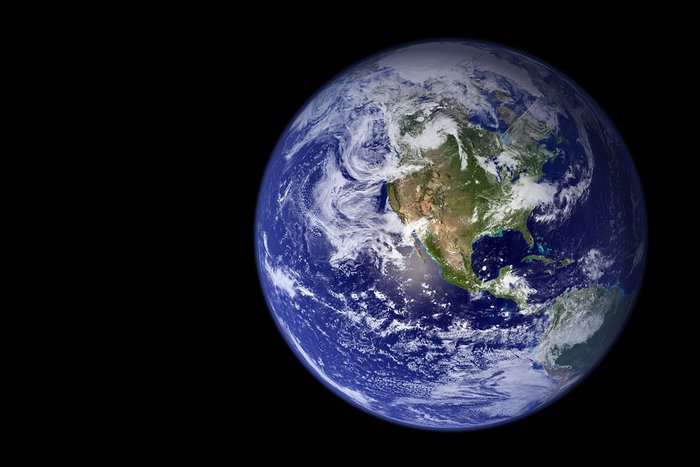University of Montana scientists and colleagues investigate the ways in which climate change could affect the efforts to safeguard biodiversity within the network of protected regions worldwide. They present their findings in the Communications, Earth & Environment journal.
 University of Montana research suggests climate change could complicate a plan to conserve 30% of the Earth by 2030. Image Credit: NASA
University of Montana research suggests climate change could complicate a plan to conserve 30% of the Earth by 2030. Image Credit: NASA
The team studied how possible shifts in biomes and ecoregions caused by climate change might alter their representation within the worldwide network of protected areas. They also looked at the effects of conservation targets that stipulate 30% of Earth’s habitats to be officially protected by 2030.
At its most basic level, this study attempts to understand what shifts in the distribution of the Earth’s ecoregions and biomes will mean for the capacity to conserve and protect biological diversity using protected areas.
Solomon Dobrowski, Study Lead Author and Professor of Forest Landscape Ecology, W.A. Franke College of Forestry and Conservation, University of Montana
Researchers have separated Earth’s terrestrial areas into approximately 800 ecoregions. An ecoregion is an ecosystem demarcated by characteristic geography and biota. These combinations of animals and plants serve as surrogates for the planet’s biodiversity and offer a means for countries, researchers and global organizations to monitor whether protected areas signify the planet’s biodiversity.
Nations worldwide use protected-area designations to protect biodiversity. Protected regions come in a variety of flavors, Dobrowski said, like national parks in the United States. But one factor they all share is fixed boundaries that define a place on the ground.
Climate change will possibly impact what ecosystems are depicted in protected areas, Dobrowski and his co-authors claim in the new study, but how still remains vague.
It is also vague how that could impact the effectiveness of conservation strategies that depend on protected areas — like the United Nations’ draft of the Post-2020 Global Diversity Framework, also referred to as 30 by 30, which necessitates perpetually protecting 30% of the Earth by 2030 by expanding the protected area network, among other endeavors.
(The United States already has the ‘America the Beautiful’ initiative, which targets to protect 30% of America’s waters and lands by 2030.) At the UN Biodiversity Conference COP-15, which begins online in October, the 30 by 30 framework will be addressed.
The UN, in coordination with many countries and international conservation organizations, is promoting the expansion of the protected area network so that 30% of all ecoregions are protected by 2030. But what happens when plants and animals, and therefore ecoregions, move over time to track their optimal climate but the protected area boundaries stay fixed in place?
Solomon Dobrowski, Study Lead Author and Professor of Forest Landscape Ecology, W.A. Franke College of Forestry and Conservation, University of Montana
“Even if 30% of a given ecoregion may be protected now, as the ecoregions shift in response to climate change, that protection and representation within the protected area network will change,” he added.
To answer these questions, the researchers used spatial climate analogs — current locations that share related climates to those estimated for a location in the future — to scrutinize how a 2°C rise in worldwide temperatures could change the distribution of ecoregions. Then the researchers examined what those changes could mean for realizing 30 by 30.
They learned that approximately half of the Earth’s land area will undergo climate conditions that match with various ecoregions.
“Climate change has the potential to dramatically shift the ecosystems of the planet,” Dobrowski said. “We project by mid-century that over 50% of ecoregions globally will have a climate associated with a totally different ecoregion. We look at the world around us, and we see ecosystems that we are used to seeing. We think they’re stable, but they’re not. And those kinds of changes are going to challenge our ability to conserve biodiversity globally.”
The authors suggest that efforts to safeguard biodiversity will need to clearly consider how climate change will stimulate deviations in the patterns of biodiversity.
We’re dealing with a moving target in terms of trying to capture the planet’s biodiversity in protected areas. In this work, we provide a model for how people can anticipate dynamic and shifting patterns of biodiversity and respond with strategic conservation investments.
Caitlin Littlefield, Former UM Postdoc and Study Co-Author, Conservation Science Partners
To spread their results more widely, the group also developed an online tool, Analog Atlas (https://plus2c.org/), to notify the public of the ways climate change could change the ecosystems in which they reside and play. Climate analogs put climate change into context by asking a basic question: “Where can I find the climate of my future, today?” Dobrowski said.
Users can choose any land area on the world map and see another location where the present-day climate matches future predicted conditions for that chosen location.
We are really excited about the Analog Atlas. It allows users to conceptualize climate change through maps, street views, and statistics such as expected changes in the number of hot days, freezing nights, and fire conducive days.
Sean Parks, Study Co-Author, Aldo Leopold Wilderness Research Institute
University of Montana researchers on the study include Dobrowski, Clark Hollenberg, Drew Lyons, and former UM-postdoctoral researcher Caitlin Littlefield, currently at Conservation Science Partners. Other co-authors include John Abatzoglou and Katherine Hegewisch at the University of California, Merced; Sean Parks from the Aldo Leopold Wilderness Research Institute in Missoula; Carlos Carroll from the Klamath Center for Conservation Research; and Josh Gage from Gage Cartographics in Bozeman.
Journal Reference:
Dobrowski, S. Z., et al. (2021) Protected-area targets could be undermined by climate change-driven shifts in ecoregions and biomes. Communications Earth & Environment. doi.org/10.1038/s43247-021-00270-z.